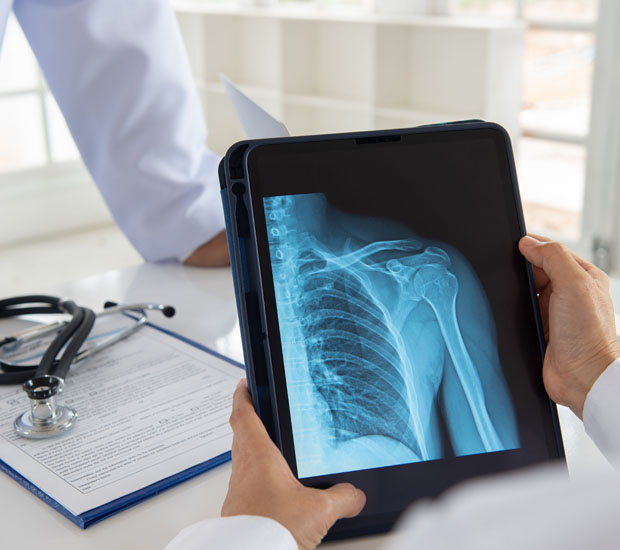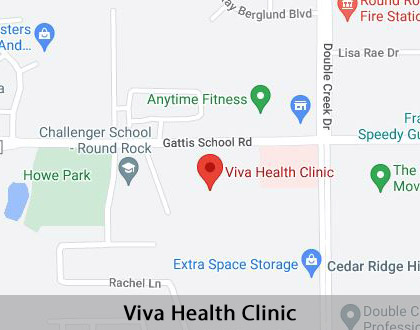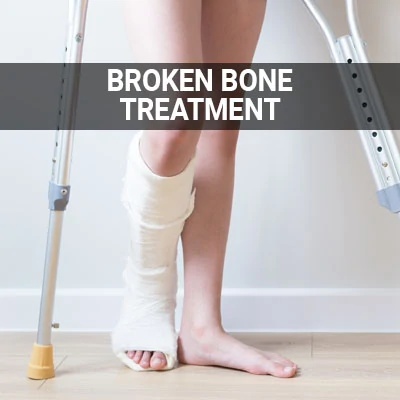Why Do I Need Joint X-Rays? Round Rock, TX
X-rays use a small amount of radiation to produce a picture of the joint inside the body. Doctors can quickly review the results to diagnose problems in the joints. Joint X-rays are a beneficial service as they pose little risk to the patient while helping the practitioner identify the source of various health conditions.
While some practitioners may have to refer you to a different practice for X-rays, we at Viva Health Clinic can take your X-rays and have our practitioners review them right at our practice. If you are located in Round Rock or the surrounding area and are experiencing joint pain, you can come in for a walk-in appointment at any time of the day.
Reasons Why a Patient Would Need Joint X-Rays
There are several reasons why patients may need joint X-rays. They can help practitioners diagnose a variety of conditions in the joints. These conditions include:
- Dislocated joint
- Cancer
- Fracture
- Trauma
Patients should remember that the above list is not exhaustive and that joint X-rays can help diagnose other unexplained symptoms. These include swelling, pain, or tenderness. Joint x-rays are also useful in detecting degenerative bone diseases (such as arthritis) and advanced infections. However, they are not as accurate as CT or MRI scans in detecting smaller abnormalities or soft tissue injuries. Additionally, while they can detect moderate to large bone breaks, they may not be able to detect small "hairline" fractures.
“There are several reasons why patients may need joint X-rays.”
What to Expect from the X-Ray Procedure
A joint X-ray is a painless and relatively simple procedure. The patient may need to wear a gown, depending on where the X-ray is performed. They will most likely also need to remove any metal objects, such as jewelry or eyeglasses, from the body. Women should also inform their practitioners if they are pregnant or could be pregnant, as radiation can harm the developing body.
To take an X-ray, patients will have to either lie down or stand up under the corresponding equipment. The X-ray technician will place the recording device under the table or behind the target joint. The patient must remain very still while the technician goes to another room to activate the radiation.
For joint X-rays, the technician will often take two to three images from different angles. Having multiple angles allows the practitioner to pinpoint the exact area of concern. In some cases, the technician will also take images of the healthy joint to compare to the area of concern. In this way, the photos of the healthy joint act as a sort of baseline comparison. Radiation will not remain in the patient's body after the X-ray.
“A joint X-ray is a painless and relatively simple procedure.”
Who Can Receive X-Rays
Joint X-rays use small amounts of radiation considered safe enough for most adults but dangerous for developing babies. As such, women who are or could be pregnant should notify their practitioners of their condition before getting an X-ray. In such cases, they may either require the practitioner's approval or undergo a different imaging method, such as an MRI.
Otherwise, most healthy adults can receive joint X-rays without any significant issues. However, if a person is undergoing an X-ray due to a painful condition, it can be uncomfortable for the patient to stay still during the test. They will need to hold their body in specific positions while the X-rays are being taken, which may temporarily worsen the pain. The practitioner may recommend taking pain medicine ahead of time to prevent this from happening.
Patients who ingest a contrast material before the X-ray may also experience some side effects, including:
- Hives
- Itching
- Lightheadedness
- Nausea
- Metallic taste in the mouth
The dye may also cause severe reactions, including anaphylactic shock, cardiac arrest, or severely low blood pressure. However, the chances of this occurring are extremely rare. Still, if patients suspect they are having a severe reaction, they should call their practitioner immediately.
It is essential to remember that joint X-rays are considered on a case-by-case basis. In other words, patients should rest assured knowing that their practitioners will only recommend them when there are no better options. Some injuries may not show up on an X-ray. They may also be identifiable via other, less complex methods. However, if patients have a twisted ankle that renders them unable to walk four steps, immobile joints, pain surrounding the bone area, or swelling that does not subside with treatment, joint X-rays may be necessary.
“… women who are or could be pregnant should notify their practitioners of their condition before getting an X-ray.”
Check out what others are saying about our primary care practitioner services on Yelp: Why Do I Need Joint X-Rays? in Round Rock, TX
What to Expect from X-Ray Results
Once all the necessary X-ray images have been taken, the patient will be able to change back into their regular clothes. The practitioner may advise them to return to their normal activities or rest while waiting for their results. In an urgent situation, they may simply need to wait until the radiologist has a chance to interpret the results.
Radiologists are the medical practitioners who are specially trained to read and understand various imaging scans' results. Since X-ray images are digital, a radiologist can view them on a screen within minutes in an urgent situation. In a non-emergency case, patients may have to wait a few days to receive their results.
Afterward, the practitioner will review the X-ray results and radiologist's report before deciding how to proceed. Depending on the results, further tests may be necessary to determine an accurate diagnosis. These tests may be additional imaging scans, blood tests, or other diagnostic exams. A prescribed course of treatment may also be necessary.
In addition to discussing the findings with the patient, the practitioner may also send a copy of the results and radiologist's report to the patient's primary care practitioner (or the practitioner who requested the X-ray, if applicable).
After the X-ray, patients who have ingested contrast material should drink lots of liquid to flush it out of their system. Temporary side effects may include white excrement, which may last up to a few days. Eyesight may also be blurry for a few hours. Those who received an iodine injection may feel sick or develop a rash. However, as mentioned earlier, these side effects are temporary. Patients should seek immediate medical attention if experiencing anaphylactic shock, cardiac arrest, or severely low blood pressure.
“Radiologists are the medical practitioners who are specially trained to read and understand the results of various imaging scans.”
Questions Answered on This Page
Q. Why do I need joint X-rays?
Q. What happens when you get an X-ray?
Q. What happens after an X-ray?
People Also Ask
Q. What are the symptoms of osteoarthritis and rheumatoid arthritis?
Q. Are fractures the same thing as broken bones?
Q. What types of treatment does a primary care practitioner offer for injuries?
Frequently Asked Questions
Q. Is it dangerous to get an X-ray?
A. Radiation exposure always carries a small risk of damage to cells or tissues. However, X-rays only use small amounts of radiation, making any risk of complications very low. Rest assured that your practitioner will only recommend you get an X-ray if it is the best option for you.
Q. Will I need to do anything special to prepare for my X-ray?
A. Usually, no. However, you may need to ingest a contrast material for your exam, in which case some preparation may be necessary. We will give you more instructions when you schedule.
Q. Can I eat or drink anything before my X-ray?
A. You can eat and drink before any general X-ray exams. However, if you need to ingest a contrast material, you may need to have an empty stomach before the exam. This allows the radiologist to examine your X-ray best.
Q. How long will it take to get an X-ray?
A. It usually does not take longer than 15 minutes to get an X-ray. However, X-rays that require contrast may take around 30 minutes. Ask your practitioner for more information.
Q. Will I be able to eat a regular meal after my X-ray?
A. Yes. You will usually be able to return to your everyday activities immediately after your X-ray unless told otherwise. However, you should remember to drink plenty of fluids to flush out any contrast material.
Start Feeling Better – Visit Us Today
By visiting us as soon as possible, our team can help get you the professional treatment you need. Instead of waiting around and allowing the symptoms to get worse, we can provide you with treatment options.
Definitions
Visit Our Office Today
Joint X-rays are painless, relatively quick procedures that can be used for a variety of reasons. These include diagnosing dislocated or fractured joints and determining if there is cancer in the joint. They can also help determine the cause of other joint problems, such as pain or swelling. If you are located near Round Rock and have questions about the joint pain you are having, you may contact Viva Health Clinic at 512-243-5872 .
Helpful Related Links
- American Assocation of Neuromuscular and Electrodiagnostic Medicine. American Assocation of Neuromuscular and Electrodiagnostic Medicine. 2023
- American Journal of Medicine. American Journal of Medicine. 2023
- American Medical Association (AMA). American Medical Association (AMA). 2023
- American Society of Radiologic Technologists. American Society of Radiologic Technologists. 2023
- American Trauma Society. American Trauma Society. 2023
- Radiological Society of North America. Radiological Society of North America. 2023
- RadiologyInfo.org. RadiologyInfo.org. 2023
About our business and website security
- Viva Health Clinic was established in 2023.
- We accept the following payment methods: American Express, Cash, Discover, MasterCard, and Visa
- We serve patients from the following counties: Williamson, Travis, McLennan
- We serve patients from the following cities: Pflugerville, Austin, Kyle, Waco, Leander, Cedar Park, Bastrop, Round Rock, Georgetown, Hutto, Liberty Hill, and Taylor
- National Provider Identifier Database (1104428416). View NPI Registry Information
- Norton Safe Web. View Details
- Trend Micro Site Safety Center. View Details
Back to top of Why Do I Need Joint X-Rays?










